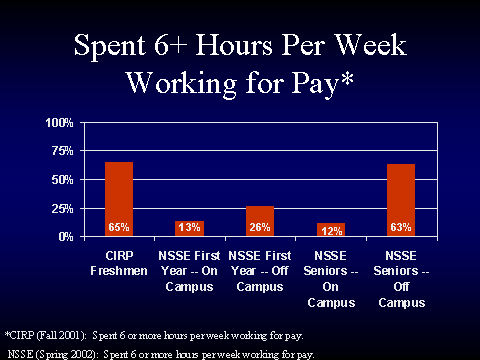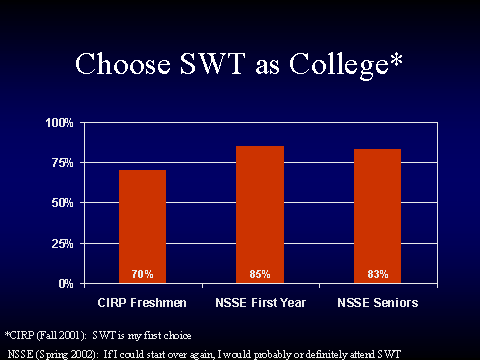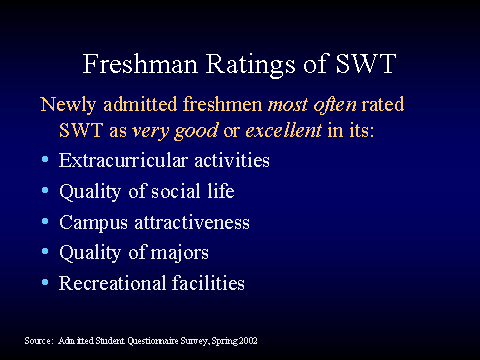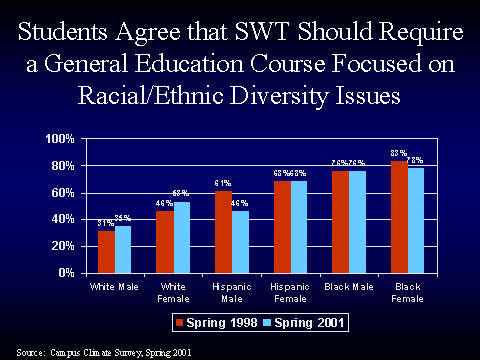| |
What follows are summaries of assessments of students’
experiences, characteristics, and opinions at SWT since 2001. These
assessments are:
- 2001 Cooperative Institutional Research Program
(CIRP) Freshman Survey
- 2002 National Survey of Student Engagement (NSSE)
Survey
- 2002 Admitted Student Questionnaire
- 2001 Campus Climate Survey
- 2002 Characteristics of Transfer Students
The full results of these assessments can be obtained from Dr. Robert
Smallwood, Associate Vice President for Academic Affairs, 245-8818,
for the NSSE study and Ms. Susan Thompson, Research Associate, Vice
President for Student Affairs Office, 245-2152, for the other four
studies.
During Fall 2001, SWT freshmen during PAWS Preview completed
the Cooperative Institutional Research Program survey. Highlights
from the 2001 Cooperative Institutional Research Program (CIRP) Freshman
Survey include:
-
During their last year of high school, SWT freshmen were like
Texas (27 Texas institutions participating in study) and National
Public University freshmen in the amount of time spent socializing
with friends, exercising or playing sports, and watching TV.

-
SWT freshmen were less likely than Texas and Public University
freshmen to study, do volunteer work, or talk with teachers outside
the class.

-
SWT freshmen were more likely than Texas and Public University
freshmen to spend time partying.
-
SWT freshmen are much less likely to come from high schools
that require community service, even though the percentage of Texas
freshmen that report a high school community service requirement
is higher than the Public University freshmen percentage.
-
SWT freshmen see themselves as cooperative and as having a drive
to achieve, much like freshmen in Texas and at Public Universities.

-
SWT freshmen are more likely to have socialized with others
of a different racial or ethnic group, much more likely to have
been bored in class, and more likely to have smoked cigarettes during
the past year than their peers who are attending other Texas schools
or Public Universities.

-
SWT freshmen also report higher levels of tardiness for class,
drinking wine or liquor, and drinking beer than freshmen elsewhere
in Texas or in Public Universities.

-
SWT was the first choice of colleges for more than two-thirds
of the new freshmen.
-
Just over a quarter of SWT freshmen applied only to SWT for
admission.
-
The top five reasons freshmen cite for deciding to attend SWT
are size of the college, good reputation for social activities,
graduates get good jobs, very good academic reputation, and low
tuition.

-
SWT freshmen are more confident than Texas and Public University
freshmen about their ability to finance a college education, less
likely to use financial aid, and more likely to depend on their
families for college funding.
-
Sixty-seven percent of SWT freshmen plan to obtain at least
a bachelor’s degree from SWT, and another 22 percent intend
to continue graduate studies at SWT to earn a master’s degree.
-
Objectives that are essential or very important to SWT freshmen
include being very well off financially (74%), raising a family
(72%), becoming an authority in their field (61%), helping others
who are in difficulty (54%) and obtaining recognition from colleagues
for contributions to their field (51%).

-
SWT freshmen indicated that chances were good that they would
socialize with someone of another racial/ethnic group (66%), develop
close friendships with other students (65%), get a job to help pay
for college expenses (42%) and be satisfied with SWT (39%).

-
SWT freshmen hold more conservative views on affirmative action,
taxes, and the death penalty than do national freshmen.
NSSE (National Survey of Student Engagement) 2002
Survey Responses:
-
Fifty percent of the freshmen and 58% of seniors used an electronic
medium to discuss or complete an assignment often or very often.
-
Sixty one percent of the freshmen and 54% of seniors
had serious conversations with students of a different race/ethnicity
than their own often or very often.
-
Only thirty percent of freshmen and 59% of seniors
worked with classmates outside of class to prepare class assignments
often or very often.
-
Seventy five percent of the freshmen and 52% of
seniors planned to do community service or volunteer work.
-
Most freshmen (71%) and seniors (72%) spend 6
or more hours per week preparing for class.

- Only 26% of the freshmen yet 63% of seniors spend 6 or more hours
per week working for pay off campus.

- Freshmen (79%) and seniors (72%) spend 6 or more hours per week
relaxing and socializing.
- Over eighty percent of freshmen (85%) and seniors (83%) said if
they could start over again, they would probably or definitely attend
SWT.

- Thirty seven percent of the freshmen and 65% of the seniors said
they often or very often asked questions in class or contributed to
class discussions.
- A high percentage of freshmen (65%) and seniors (67%) often used
e-mail to communication with an instructor.
- Freshmen (28%) at SWT were significantly higher than comparable
schools (17%) in often or very often coming to class without completing
readings or assignments.
- Freshmen (9%) and seniors (15%) were significantly lower than comparable
schools (11% and 19% respectively) in often or very often working
with faculty members on activities other than coursework such as committees,
orientation, and student life activities.
- Freshmen (37%) and seniors (65%) were significantly below comparable
schools (59% and 73% respectively) in often or very often asking questions
in class or contributing to class discussions.
- Seventy percent of the freshmen and 65% of the seniors evaluated
the quality of academic advising received at SWT as good or excellent.
- Eighty nine percent of the freshmen and seniors evaluated their
entire educational experience at SWT as good or excellent.
Students admitted to SWT for Fall 2002 were asked
to respond to the Admitted Student Questionnaire. Responses included
students who enrolled and students who did not enroll. Highlights from
the Admitted Student Questionnaire Plus 2002 include:
- 70% of the students admitted to SWT who responded to the Admitted
Student Questionnaire listed academic reputation as being very important.
The difference between the enrolled students (65%) and non-enrolled
students (74%) is statistically significant.
- The top five college characteristics associated with SWT rated “very
good” or “excellent” were the extracurricular activities,
quality of social life, campus attractiveness, quality of majors and
recreational facilities.

- The bottom five college characteristics rated as “fair/poor”
or “good” were the availability of merit scholarships, academic
reputation, on-campus housing, environment of academic achievement
and cost of attendance.

- The top five images most associated with SWT (in descending order):
fun (85%), partying (78%), social (71%), friendly (69%), and comfortable
(64%).
- The bottom five images most associated with SWT (in ascending order):
selective (4%), isolated (6%), prestigious (8%), and not well known
(8%).

- Of the college characteristics considered “very important”
by the majority of admitted students (over 50% of respondents), SWT’s
mean rating was above that of all other colleges in cost of attending
and surroundings.
- The most used information sources were college publications (89%),
college website (85%), post-admission communication (85%), campus
visit (75%) and financial aid communications (65%).
- The average student applies to 3.5 colleges (enrolled at 2.5 and
non-enrolled at 4.3) and is admitted to 3.2 colleges (enrolled at
2.2 and non-enrolled at 3.8).
- The survey supports previous information regarding SWT’s “overlap”
institutions. The top five institutions to which other students apply
are the University of Texas (34%), Texas A & M (34%), Texas Tech
(17%), Stephen F. Austin State (12%), and the University of North
Texas (12%).
- Over 50% of the non-enrolling high achieving students associated
back up school with SWT.
Responses from the Spring 2001 Campus Climate Survey:
- Overall, comfort levels with others who differ in race/ethnicity,
sex, ability, or sexual orientation increased from 1998 too 2001.
- Nearly three-fourths (73%) of students are very comfortable with
students of a different race or ethnicity than their own.
- Half (50%) of students are very comfortable with students of a different
sexual orientation, and 26 percent are moderately comfortable. Females
are more comfortable than males with students of different sexual
orientation (55 percent of females are very comfortable compared to
39 percent of males).
- Almost half (48%) of students are very comfortable with students
with physical or learning disabilities.
- Overall, students reported fewer experiences with discrimination
in 2001 compared to 1998.
- Sixteen percent of Black students perceive at least occasionally
to have received less attention in class from a faculty member or
teaching assistant because of ethnicity, compared to nine percent
of Hispanic students and two percent of White students.
- Levels of satisfaction with overall experiences increased the most
among Hispanic females (from 66 to 77%) and Black males (from 60 to
71%). No Black males reported being “very dissatisfied”
in Spring 2001, compared to nine percent in 1998.
- White males are most satisfied (82%) with overall experiences, while
Black females are less satisfied (63%).
- Black females (76%) feel ethnic minority students are singled out
in the classroom as experts on ethnic issues, compared to less than
60 percent for all other groups. This is down slightly from 80 percent
for Black females in 1998.

- In 2001, less than 36 percent of all ethnic minority students felt
that someone assumed that they were admitted because of their membership
in a racial/ethnic group compared to a high 80 percent in 1998.
- While males (35%) continue to be least likely to support required
courses about diverse groups. More than 76 percent of Black students,
both male and female, and 68 percent of Hispanic females support diversity
courses.

- Beliefs about financial aid continue to vary by ethnicity. The
majority of White students (84%) believe that more financial aid is
available for racial/ethnic minority students, while 53% of Black
and 35 percent of Hispanic students believe more financial aid is
available for White students.
- Black women’s satisfaction with administrators’ efforts
to foster diversity increased the most of any ethnic/gender group
between 1998 and 2001 from 36 to 58 percent. In 1998, Black women
were the most dissatisfied group with regard to diversity efforts
by the SWT administration. Black males’ satisfaction with administrators’
efforts increased from 37 to 55 percent and Hispanic males’ satisfaction
increased from 59 to 72 percent between 1998 and 2001.
- Students in 2001 agreed more strongly that the president and other
SWT administrators provide visible leadership that fosters campus
diversity with regard to gender, racial/ethnic group, and sexual orientation
than did students responding to the 1998 survey.
Data about Fall 2002 Transfer Students:
- Sixty one percent of the new SWT undergraduates are transfer students.
Of these transfer students, 33% are from four year institutions while
67% are from two year institutions.


- Seventy percent of the transfer students are between the ages of
19-22 years old.
- Thirty six percent of the transfer students come from the Central
Texas region, 22 % from the Upper Gulf region and 21% from the South
Texas region.
- Sixty four percent of the transfers live out of town, 21% live on
campus and 15% live in San Marcos.
- The majority of the transfers, 58%, are classified as sophomores
while 30% are classified as juniors.
- Forty one percent of the transfers had a decision gpa between 2.50-2.99,
27% had a decision gpa of 3.00 – 3.49, and 24% had a decision
gpa between 2.00 – 2.49.
- The majority of the transfer students (56%) had came to SWT with
college hours between 30-59 hours while 31% came with college hours
between 60-89 hours.
- The cumulative gpa for the Fall 2001 transfer cohort after one year
at SWT is 2.67 and these students had a 79% retention rate.
|
|

















